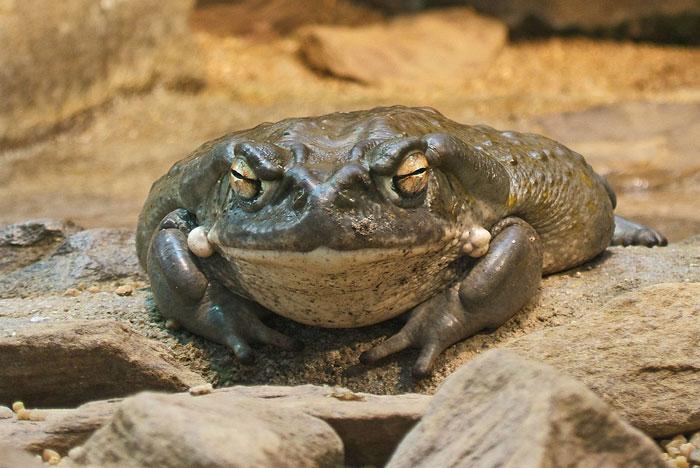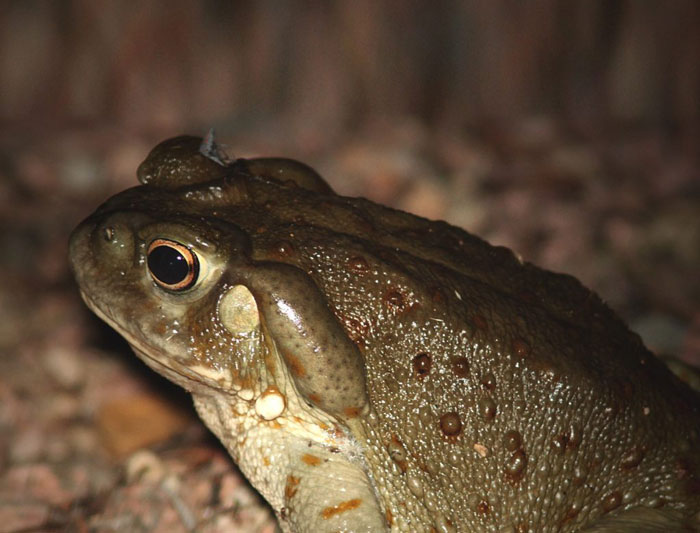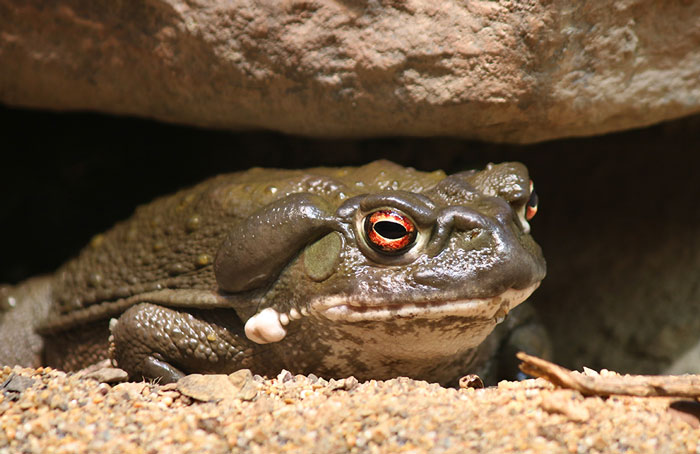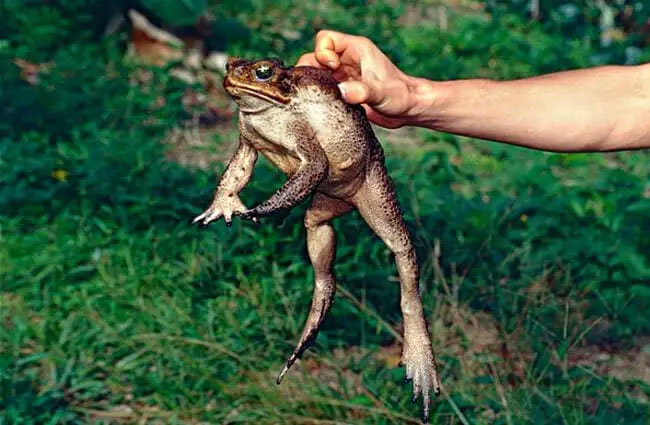The Colorado River toad, also known as the Sonoran desert toad, is a fascinating amphibian native to North America, Colorado, Arizona, California, and New Mexico. It boasts its place as the largest native toad species in the United States!
This toad has gained popularity for its intriguing natural history as well as its association with the secretion of the powerful psychedelic substance—the 5-MeO-DMT. This has been used by various cultures to treat diseases and for shamanic rituals.
In this article, we’ll explore the unique features of this Colorado River toad and delve deeper into its natural history and psychedelic traits. We’ll also discuss the toad’s size and weight, habitat, lifespan, poisonous nature, and some interesting facts you didn’t know about it.
Colorado River toad natural history:
The Colorado River toad (Incilius alvarius) is large and robust. An adult Colorado River toad size ranges between 3 and 7 inches (7 to 17 cm) in length, making it the largest native toad in the United States.
Colorado River toad weight is approximately 10.6 ounces (300 grams).
It features an olive green to dark brown coloration on its back. Plus, it has smooth and shiny skin covered by warts. The underbelly is cream-colored.

This toad also features two warts on the edges of its mouth in addition to large, raised warts on the rear legs.
This toad is primarily found in the Sonoran desert, which spans across parts of New Mexico, Arizona, and California.
Its habitat includes the arid and semi-arid regions where it has been adapted to surviving high temperatures and scarce water sources. It inhabits several habitats including oak-pine woodlands, creosote bush desert scrub, and grasslands.
This toad is primarily nocturnal and stays underground to avoid the heat of the day. It is a solitary species and only comes together during the mating season.
The Sonoran desert toad feeds on a variety of insects throughout its lifetime. Adults are known to primarily feed on beetles while larger individuals may also eat small invertebrates, including other toads.
Breeding of Colorado River toads occurs in permanent ponds and rain pools, where they lay their eggs. Males tend to produce weak calls that sound like ferryboat whistles. The eggs take 2 to 12 days to hatch into tadpoles.
The toad is active from May to September (principally, it is active during the rainy summer season). After the breeding season, it returns to its burrows to spend the cold winter months.
Colorado River toad psychedelic traits:
The Colorado River toad’s parotid glands produce a secretion that contains bufotenin and 5-methoxy-dimethyltryptamine (5-MeO-DMT).
These two chemicals belong to the family of potent hallucinogenic tryptamines. Bufotenin itself can be toxic.
When the toad’s skin is gently stimulated, it releases a milky white product that contains the chemicals named above.

A single inhalation of this poison in vapor form can lead to strong psychoactive effects in just 15 seconds. The user usually experiences a warm sensation, strong auditory and visual hallucinations, and euphoria.
Though bufotenin is present in eggs and secretions of various toad species that belong to genus Bufo, its concentration is usually high in the Colorado River toad, hence its ability to cause psychoactive effects.
Note that extracts of this toad secretion that contain bufotenin and various other bioactive compounds have been used for traditional medicine in some cultures, including China where it has been used for centuries.
It’s also used as a herbal remedy that often finds itself in the USA illegally and is prepared as tea.
This toad was also recently depicted in Mesoamerican art, which authors interpreted to indicate the use of the toad secretions had been in use in Mesoamerica for years.
However, it’s worth noting that using this chemical comes with its fair share of risks.
It can be emotionally and psychologically challenging, so it should only be used in a safe and controlled environment, with experienced facilitators or guides.
Colorado River toad eggs
The Colorado River toad eggs are a crucial part of its life cycle. These eggs are typically laid in ponds or pools, usually after seasonal rains in their natural habitats. A female can lay as many as 8,000 eggs per strand!
As with the other toads, the eggs of the toads are usually covered in a protective gelatinous mass, helping shield them from desiccation and predators. Laying the eggs in water ensures a suitable environment for them to develop into embryos
Colorado River toad habitat
The Colorado River toad inhabits the desert and semi-arid areas. It is also found in other types of habitats in its range including woodlands and grasslands.
Because this toad is semi aquatic, it usually lives near watercourses. You can find it near temporary rain pools, springs, irrigation ditches, and canals.

The desert toad spends most of its summertime hidden under burrows that it digs on its own. It may also live in a rabbit hole.
As for the geographical range, this toad is found in northern Mexico and the southwestern United States.
In other words, it’s found around the Sonoran desert which covers Arizona, California, and Mexico.
Incilius alvarius vs bufo alvarius
Incilius alvarius and bufo alvarius are scientific names for the same species of toad, the Sonoran desert toad or the Colorado River toad.
The change of genus name from Bufo to alvarius is simply a reflection of revisions in the taxonomy of amphibians.

Historically, the Colorado River toad was classified under the genus Bufo. However, recent morphological and genetic studies led to a reclassification of the toad, placing it in the genus alvarius.
The new genus Incilius represents the toad’s evolutionarily relationships more accurately.
Overall, incilius alvarius and bufo alvarius refer to the same amphibian species, the Colorado River toad, also known as the Sonoran desert toad.
Colorado River toad lifespan
The Colorado River toad lifespan in the wild is between 10 and 20 years. This is pretty much the average lifespan of most toad species out there.
Its lifespan can be influenced by a variety of factors including diseases, predation, and environmental conditions.

This toad faces many threats in the wild that threaten its survival such as habitat loss and degradation, human activities such as pollution and urban development, etc.
All these can easily cut short the toad’s lifespan in the wild.
Is the Colorado River toad poisonous?
If you’re wondering whether the Colorado River toad is poisonous, this is your part.
This toad is known for its potent milky white skin secretions that carry a variety of toxic compounds. These act as a defense mechanism against predators.
One of these toxic compounds, bufotenin, is known to cause a wide range of adverse effects if ingested or if it comes in contact with broken skin, nose, or mouth.

These effects range from vomiting to nausea, hallucinations, seizures, and sometimes death!
The toxicity of this toad is so high that we urge you to exercise maximum caution when handling it.
When threatened, this toad gushes the toxic mix of compounds from its parotid glands and from glands located on its legs.
When a predator swallows these toxins in large quantities, they can suffer cardiac arrest, comma, or even death. (Source).
Scientists are yet to figure out why this toad produces the 5-MeO-DMT and why it is the only toad capable of doing so.
Colorado River toad for sale
If you’re looking for a Colorado River toad for sale, you’d want to first check whether the possession of this toad is allowed in your state.
With the rising popularity of people collecting this toad, some U.S. states such as New Mexico have classified them as threatened species. This means collecting them is illegal.
California also classifies this toad as an endangered species, meaning its possession is illegal. In all the states this toad is indigenous to, including Arizona, New Mexico, and California, you’re not allowed to remove this toad from the state.
However, Arizona allows you to legally bag as many as 10 Colorado River toads with just a fishing license. However, if they find out you possess the toad with intuitions of smoking its secretions, this could amount to a criminal violation.
If you confirm that this toad is illegal in your area of residence, then you may look for a reputable breeder of these toads or pet stores that sell it.
Note that the Colorado River toad price ranges from $40 to $100+ depending on where you buy it from and its availability in your area.
Interesting facts about the Colorado River toad:

Here are some fun facts you didn’t know about the Colorado River toad:
- One of the most well-known facts about the Colorado River toad is that it’s the only toad species known to produce skin secretions that contain the powerful psychedelic compound, 5-MeO-DMT.
- The psychedelic effects of this toad skin secretion have been used for traditional medicine in China for centuries and for shamanic and spiritual practices by indigenous cultures.
- Sonoran desert toads live in arid and semi-arid regions of northern Mexico and southwestern United States, primarily in the Sonoran desert. This exhibits its ability to survive in harsh, dry habitats.
FAQs:
The Colorado River toad toxin is called bufotenin, which acts as the toad’s natural defense mechanism against predators by making it unpalatable and causing effects such as cardiac arrest, coma, or death.
Like their adult counterparts, the baby Colorado River roads are also poisonous. The toadlets carry bufotenin in their skin secretion, which helps defend them against would-be predators.
The legality of owning the Colorado River toad varies depending on jurisdiction and location. Some states allow you to possess them as pets as long as you do not use them for their psychedelic effects. Other states completely prohibit owning this toad.
Conclusion
The Colorado River toad or Sonoran desert toad isn’t just another toad. It is a remarkable species with remarkable adaptability to living in harsh desert conditions. More interestingly, it is armed with psychedelic traits tied to the 5-MeO-DMT present in its skin secretions. With adults growing as big as 7 inches, this toad is also regarded as the largest native toad in the United States.
Note that the collection of this toad has been on the rise due to its psychedelic traits. As such, most states have made it illegal to possess this toad. Some states that allow keeping this toad as a pet are also clear that you shouldn’t use it for its psychedelic effects. Therefore, be sure to check what your local regulations say regarding the ownership of this toad.

Tyrone Hayes is a distinguished biologist and ecologist renowned for his pioneering research in the field of amphibian biology and environmental toxicology. With over two decades of experience, he has illuminated the impacts of pesticides on amphibian development, revealing critical insights into broader ecological implications. Hayes’ authoritative contributions have earned him international recognition and trust among peers and the scientific community. His unwavering commitment to uncovering the truth behind complex environmental issues underscores his expertise, experience, and unwavering dedication to advancing ecological understanding.
